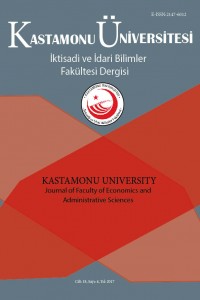Öz
Geleneksel
modeller ithalat talep fonksiyonunu reel gelir ve nispi ithalat fiyatları ile
ilişkilendirilirken uluslararası rezervleri göz ardı etmiştir. Ancak sonraki
dönemde yapılan çalışmalarda uluslararası rezervlerin ithalat talebinin önemli
bir belirleyicisi olduğu tespit edilmiştir. Bu kapsamda bu çalışmada Türkiye’deki
ithalat talebi ile uluslararası rezerv miktarı arasındaki ilişki 2010 Ocak –
2017 Ocak dönemi için incelemiştir. Hacker-Hatemi J(2012) nedensellik
analizinin yanı sıra Hatemi-J (2012) asimetrik nedensellik testi kullanılmıştır.
Elde edilen bulgulara göre uluslararası rezervlerden ithalata doğru nedensellik
ilişkisi elde edilmiştir. Pozitif şoklarda herhangi bir nedensellik bulgusuna
ulaşılamazken, negatif şoklarda ise çift yönlü ilişki olduğu sonucuna
ulaşılmıştır.
Anahtar Kelimeler
İthalat Miktarı Uluslararası Rezervler Döviz Rezervleri Reel Gelir Nispi İthalat Fiyatları Hacker-Hatemi J(2012) Nedensellik Analizi Hatemi J(2012) Asimetrik Nedensellik Testi
Kaynakça
- Arize, A.C.,Osang, T., &Slottje, D. J. (2000).Exchange-Rate VolatilityandForeignTrade: EvidencefromThirteenLDCs. Journal of Business andEconomicStatistics, 18, 10-17. Arize, A.C.,Malindretos, J., &Grivoyannis, E. C. (2004). Foreign Exchange ReservesandImportDemand in a Developing Country: The Case of Pakistan.InternationalEconomicJournal, 18(2), 259-74. Arize, A.C.,Osang, T. (2007). “Foreign Exchange ReservesandİmportDemand: Evidencefrom Latin America”, The World Economy, 30, pp.1477-1489. Arize, A.C.,Malindretos, J. (2012). “Foreign Exchange Reserves in Asiaandİtsİmpacton İmportDemand”, İnternationalİmpact on İmportDemand”, Vol.4, No.3, pp.21-32. Aziz, M. N. (2013). "Modelling of ImportDemandFunctionfor a Developing Country: An EmpiricalApproach", Asian-AfricanJournal of EconomicsandEconometrics, Vol. 13, No. 1, pp. 1-15. Dutta, D.,&Ahmed, N. (1999). An AggregateImportDemandFunctionforBangladesh: A ContegrationApproach’,AppliedEconomics, 31(4), 465-472. Faini, R.,Pritchett , L., &Clavijo, F. (1992). ImportDemand in DevelopingCountries, in M.G. DagenaisandP.A.Muet (eds), International TradeModelling, (New York: Chapman&Keganpaul). Hacker S and Hatemi-J A, (2012). A Bootstrapcausality Test withEndogenousLagOrder: Theoryand Application in Finance," Journal of EconomicStudies , 39(2), 144-160. Hatemi-J, A. (2012), Asymmetric Causality Tests with an Application. Empirical Economics, 43, 447–456. Hibbert, K.,Thaver, R. andHutchinson, M. (2012). "An Econometric Analysis of Jamaica'sİmportDemandFunctionwiththe US and UK", The International Journal of Business and Finance Research, 6(1), pp.109-120. Irefin and Yaaba (2011). “Determinants of ForeignReserves in Nigeria: An Autoregressive Distributed Lag Approach”, CBN Journal of Applied Statistics, Vol.2, No.2, pp.63-82. İbrahim, M. A. (2017). "An Examination of theMerchandise İmports Demand Function for Egypt", Applied Economics and Finance, 4(2), pp. 101-112. Kotan, Z and Saygili, M. (1999). Estimating an ImportFunctionforTurkey. DiscussionPaper No. 9909, The Central Bank of theRepublic of Turkey. Moran, C. (1989). Importsunder a Foreign Exchange Constraint. The World Bank EconomicReview, 3(2), 279-95. Osei, V. (2012). “İmportDemandandEconomicGrowth Analysis”, Journal of EconomicsandSustainable Development”, Vol.3, No.14, pp.73-90. R. Scott Hacker & Abdulnasser Hatemi-J (2006) Tests for causality between integrated variables using asymptotic and bootstrap distributions: theory and application, Applied Economics, 38:13, 1489-1500. Romero, Ana Maria (2005). "ComparativeStudy: FactorsthatAffectForeignCurrencyReserves in ChinaandIndia", ThePark Place Economist”, Vol.13, pp.79-88. Sultan, Z.A. (2011). “Foreign Exchange Reservesandİndia’sİmportDemand: A CointegrationandVectorErrorCorrection Analysis”, İnternationalJournal of Business and Management, Vol.6, No.7, pp.69-76. Thaver, R. (2012). “WhatDrives South Africa’sDisaggregatedİmportDemandFunctionwithTanzania? An Empirical Analysis”, International Business: Research, TeachingandPractice, 6(1), pp.60-75.
Öz
Kaynakça
- Arize, A.C.,Osang, T., &Slottje, D. J. (2000).Exchange-Rate VolatilityandForeignTrade: EvidencefromThirteenLDCs. Journal of Business andEconomicStatistics, 18, 10-17. Arize, A.C.,Malindretos, J., &Grivoyannis, E. C. (2004). Foreign Exchange ReservesandImportDemand in a Developing Country: The Case of Pakistan.InternationalEconomicJournal, 18(2), 259-74. Arize, A.C.,Osang, T. (2007). “Foreign Exchange ReservesandİmportDemand: Evidencefrom Latin America”, The World Economy, 30, pp.1477-1489. Arize, A.C.,Malindretos, J. (2012). “Foreign Exchange Reserves in Asiaandİtsİmpacton İmportDemand”, İnternationalİmpact on İmportDemand”, Vol.4, No.3, pp.21-32. Aziz, M. N. (2013). "Modelling of ImportDemandFunctionfor a Developing Country: An EmpiricalApproach", Asian-AfricanJournal of EconomicsandEconometrics, Vol. 13, No. 1, pp. 1-15. Dutta, D.,&Ahmed, N. (1999). An AggregateImportDemandFunctionforBangladesh: A ContegrationApproach’,AppliedEconomics, 31(4), 465-472. Faini, R.,Pritchett , L., &Clavijo, F. (1992). ImportDemand in DevelopingCountries, in M.G. DagenaisandP.A.Muet (eds), International TradeModelling, (New York: Chapman&Keganpaul). Hacker S and Hatemi-J A, (2012). A Bootstrapcausality Test withEndogenousLagOrder: Theoryand Application in Finance," Journal of EconomicStudies , 39(2), 144-160. Hatemi-J, A. (2012), Asymmetric Causality Tests with an Application. Empirical Economics, 43, 447–456. Hibbert, K.,Thaver, R. andHutchinson, M. (2012). "An Econometric Analysis of Jamaica'sİmportDemandFunctionwiththe US and UK", The International Journal of Business and Finance Research, 6(1), pp.109-120. Irefin and Yaaba (2011). “Determinants of ForeignReserves in Nigeria: An Autoregressive Distributed Lag Approach”, CBN Journal of Applied Statistics, Vol.2, No.2, pp.63-82. İbrahim, M. A. (2017). "An Examination of theMerchandise İmports Demand Function for Egypt", Applied Economics and Finance, 4(2), pp. 101-112. Kotan, Z and Saygili, M. (1999). Estimating an ImportFunctionforTurkey. DiscussionPaper No. 9909, The Central Bank of theRepublic of Turkey. Moran, C. (1989). Importsunder a Foreign Exchange Constraint. The World Bank EconomicReview, 3(2), 279-95. Osei, V. (2012). “İmportDemandandEconomicGrowth Analysis”, Journal of EconomicsandSustainable Development”, Vol.3, No.14, pp.73-90. R. Scott Hacker & Abdulnasser Hatemi-J (2006) Tests for causality between integrated variables using asymptotic and bootstrap distributions: theory and application, Applied Economics, 38:13, 1489-1500. Romero, Ana Maria (2005). "ComparativeStudy: FactorsthatAffectForeignCurrencyReserves in ChinaandIndia", ThePark Place Economist”, Vol.13, pp.79-88. Sultan, Z.A. (2011). “Foreign Exchange Reservesandİndia’sİmportDemand: A CointegrationandVectorErrorCorrection Analysis”, İnternationalJournal of Business and Management, Vol.6, No.7, pp.69-76. Thaver, R. (2012). “WhatDrives South Africa’sDisaggregatedİmportDemandFunctionwithTanzania? An Empirical Analysis”, International Business: Research, TeachingandPractice, 6(1), pp.60-75.
Ayrıntılar
| Bölüm | Sayı |
|---|---|
| Yazarlar | |
| Yayımlanma Tarihi | 22 Aralık 2017 |
| Gönderilme Tarihi | 27 Temmuz 2017 |
| Yayımlandığı Sayı | Yıl 2017 Cilt: 19 Sayı: 4 |


